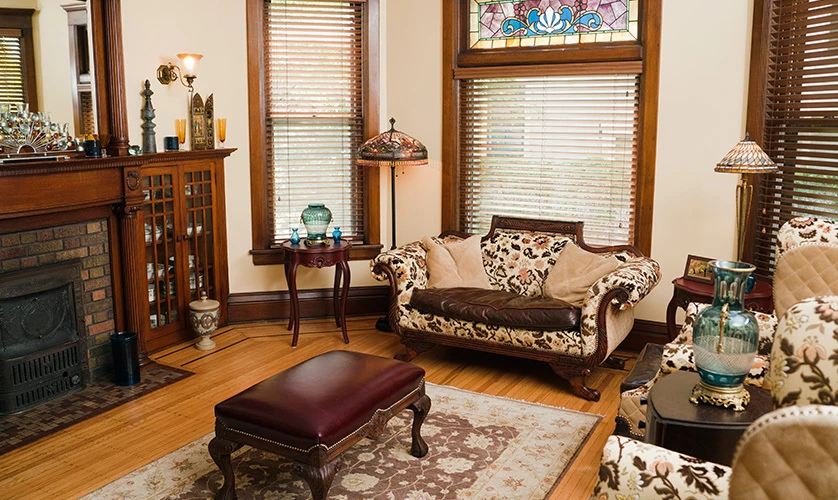Classic, older homes may radiate beauty and charm, but they are often uncomfortably drafty – especially during cold months. Unlike today’s airtight homes, many old houses have a natural ventilation system. They “breathe” through air leaks, and houses built before the 1960s were usually not well insulated.
If you’re shivering in an old house, you may be tempted to hire someone to blow insulation in. But that might be a bad idea! Before you take that step, learn how to insulate an old house effectively. Some common insulation methods can actually cause long-term damage.

Insulating the Attic and Roof
Roughly a quarter of the average home’s heat is lost through the roof. Rather than insulating the whole home and potentially causing problems like excess humidity, you can properly seal the attic of an old house. This is a safe first step to retaining heat and saving energy. Any gaps or cracks that allow warm air to travel through the ceiling into the attic or rafters need to be sealed using an appropriate sealant (caulk, weatherstripping, fireproof foam sealant, etc.).
Common areas of leaks include gaps around chimneys, ceiling fans, light fixtures, wiring, ductwork, exhaust fans and pipes. Check around windows or vents, and examine the perimeter, looking for tiny gaps or holes. Once air leaks have been addressed, you can add insulation. Batt insulation can be added to the underside of the roof between rafters, and a layer of batt or loose insulation can be added over the attic flooring. Depending on your climate, an R-value between 38 and 60 is optimal. (Check here for Energy Star recommendations.)
Consider asking a local handyman team like Mr. Handyman to help you with attic insulation.
Other tips include:
- Check existing insulation for dampness and signs of mold or mildew, and discard accordingly. (Mold exposure can be a serious health risk. If you’ve noticed mold growth anywhere in your home, professional removal is the safest bet.)
- Be sure that your attic has proper, unblocked ventilation – a soffit vent to draw air in and a ridge vent to expel air outside. (Check your state’s code for specific requirements.)
- If you’re using a vapor barrier (or batt insulation that has them attached), the barrier should face the warm side: down (facing the floor) for cold climates, and up (facing the roof) for hot climates.
- If you are layering new insulation over existing insulation, be sure that vapor barriers are not placed between the insulation layers. Remove barriers from new batting, if necessary.
- Consider installing metal roofing. Metal roofs are lightweight, durable and energy efficient.
Seal Basements and Crawl Spaces
Another way to improve an old home’s indoor climate – without hurting the home’s natural ventilation – is by sealing basements and crawl spaces. Seal cracks around basement windows and air vents, and gaps around ductwork, electrical wiring and pipes. Add well covers to egress windows, if not already present. Install vapor or moisture barrier, and/or apply a waterproof sealing compound to walls and floors. For extra protection, add batt insulation to floor joists. (If you are insulating a crawl space, be sure that entry points are appropriately covered to keep rodents out.)
How to Insulate Walls in an Old House
Knowing how to insulate walls in an old house may not be as important as knowing whether to insulate them. Many homeowners have made the mistake of drilling holes in walls, blowing in cellulose insulation and tightly sealing walls back up. This method may allow condensation to form inside walls. Moisture can build up, eventually leading to mold, wood rot, and foggy windows.
One way to insulate walls of an old house is to focus on the home’s exterior:
- Apply a house wrap/vapor barrier to exterior walls.
- Attach 1-inch foam board insulation.
- Install siding over the insulation.
- Replace old windows with energy-efficient units.
- Caulk window trim and use weatherstripping to reduce air leaks.
If you’ve tried everything else and are determined to insulate the walls of an old house, follow these tips to minimize risk:
- Remove weather barrier and cladding before drilling holes.
- Replace single-pane windows with energy-efficient windows.
- Replace or add water-resistant flashing.
- Blow in loose foam insulation, and seal drill holes.
- Follow prior steps for exterior wall insulation.
More Ways to Help Keep Old Houses Warm and Toasty
Besides covering leaks and adding insulation, ensuring that your heating and ventilation system is functioning properly is essential. Old, inefficient furnaces may not be able to keep up with the heating demands of spacious, historic homes on cold winter nights. Consider enlisting an HVAC expert to upgrade to an energy-efficient model.
Another tip: Seal and insulate heating/cooling ducts, especially those that run through cooler spaces like attics, basements and unheated garages. Use mastic sealant or foil tape to seal seams and joints, and wrap them in duct insulation.
Hire a Professional
Older houses have a lot to offer. Unique architecture, spacious rooms, and elegance are a few perks that come to mind, but remodeling projects can be complicated. There are many factors to consider before jumping in. For example, houses built prior to 1978 may have lead-based paint that should be removed before you renovate. Many old homes have plaster walls that require special care when hanging pictures or other items.
Whether you’re undertaking a simple update or tackling a large-scale project like installing insulation, Neighbourly has an entire family of home service experts ready to help! Check out the many services of our top-notch brands, and schedule an appointment today!



 Back
Back
 1 (833) 339-1953
1 (833) 339-1953




